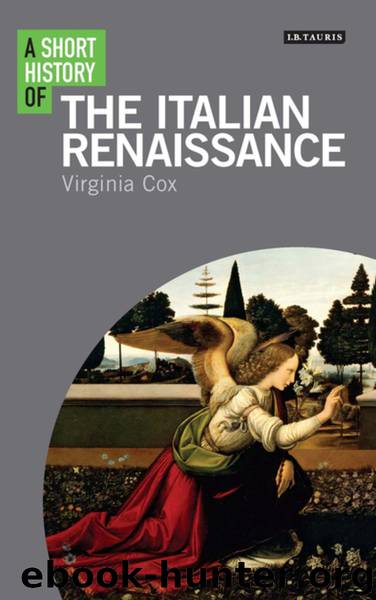A Short History of the Italian Renaissance by Cox Virginia

Author:Cox, Virginia [Cox, Virginia]
Language: eng
Format: epub
Tags: History
ISBN: 4444011
Goodreads: 26023610
Publisher: I. B. Tauris & Company
Published: 2015-11-30T08:00:00+00:00
THE COURTIER
Although it is coherent to speak of a ‘Renaissance merchant’, particularly with regard to patronage, personal style, and learned interests, the social type of the Renaissance merchant has deep medieval roots. The twelfth and especially the thirteenth centuries saw merchants and guildsmen rising to prominence within the central and northern Italian republics, where they established themselves ultimately as the dominant political class. The thirteenth and fourteenth centuries also saw the development of some of Italian business culture’s key technical instruments, such as double-entry book-keeping, mercantile insurance contracts, letters of credit, bills of exchange. Boccaccio, whose father worked for the Bardi bank, and who himself started out as an apprentice in the bank’s Naples branch, gives a vivid portrait of fourteenth-century mercantile life in his Decameron, to the extent that the Boccaccio scholar Vittore Branca termed the work ‘the epic of the merchants’.14
By contrast, the figure of the courtier, another key protagonist of the Renaissance, emerged as a defined social type much later. The Italian city-republics had already begun to give way to signorie by the later thirteenth and fourteenth centuries, but the courts of these early signori were relatively modest entities, consisting of little more than the immediate famiglia or household of the lord. The only exception, to the south, was the royal court of Naples, ruled by the French Angevin dynasty, and an important conduit for French cultural models. It was in the later fourteenth and fifteenth centuries, as the precarious signorie of the centre and north of Italy began to consolidate their power, that the courts began to grow in size, splendour, and ambition. An expansionist development of this period was the tendency for courts within courts to proliferate; in Ferrara, by the time of Ercole I d’Este, who ruled from 1471–1505, besides the duke’s own court, which amounted to over 500 employees, his wife Eleonora d’Aragona, and his three brothers and four sons all had their own substantial entourages, ranging from 25 to 140 employees.15
As the courts rose in size and ambition, they assumed an ever-higher cultural status in Italy as centres of learning and artistic, musical, and dramatic production, coming to rival more established republican cultural powerhouses such as Florence. This was all the more so when the papal court returned to Rome from a long period of ‘exile’ in Avignon in the early fifteenth century, and successive popes set themselves to rebuilding Rome as a great cultural capital. Accompanying these material changes, we see the court assuming an increasing discursive salience across the course of the mid-fifteenth century, as shorthand for a particular way of living, of speaking, of styling oneself: ‘a main reference point in the organization of upper-class consciousness’.16 Often, the court was presented negatively, as a place of corruption and insincerity, continuing a medieval tradition of writing on the ‘miseries of courtiers’. A classic of this miserabilist genre is Enea Silvio Piccolomini’s treatise De curialium miseria of 1444. More innovatively, the Florentine humanist Lapo da Castiglionchio, in his De curiae commodis
Download
This site does not store any files on its server. We only index and link to content provided by other sites. Please contact the content providers to delete copyright contents if any and email us, we'll remove relevant links or contents immediately.
The Art of Boudoir Photography: How to Create Stunning Photographs of Women by Christa Meola(18500)
Red Sparrow by Jason Matthews(5360)
Harry Potter 02 & The Chamber Of Secrets (Illustrated) by J.K. Rowling(3612)
In a Sunburned Country by Bill Bryson(3466)
Drawing Cutting Edge Anatomy by Christopher Hart(3437)
Figure Drawing for Artists by Steve Huston(3360)
Harry Potter and the Prisoner of Azkaban (Book 3) by J. K. Rowling(3289)
The Daily Stoic by Holiday Ryan & Hanselman Stephen(3212)
Japanese Design by Patricia J. Graham(3094)
The Roots of Romanticism (Second Edition) by Berlin Isaiah Hardy Henry Gray John(2867)
Make Comics Like the Pros by Greg Pak(2835)
Stacked Decks by The Rotenberg Collection(2790)
Draw-A-Saurus by James Silvani(2631)
Harry Potter and the Deathly Hallows (7) by J.K. Rowling(2626)
Tattoo Art by Doralba Picerno(2578)
On Photography by Susan Sontag(2560)
Churchill by Paul Johnson(2493)
The Daily Stoic by Ryan Holiday & Stephen Hanselman(2440)
Foreign Devils on the Silk Road: The Search for the Lost Treasures of Central Asia by Peter Hopkirk(2421)
